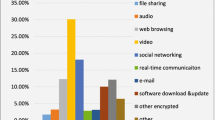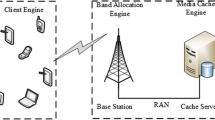Abstract
Due to the dense deployed base stations and the growing traffic of best effort (BE) services, frequent bursty interference becomes one of major challenges to assure quality of experience (QoE) for real-time video services. Considering those situations, a novel dynamic interference shaping method has been proposed in this paper, to assure the QoE for real-time video services. Firstly, to evaluate the quality impairment induced by bursty interference, we proposed a new QoE prediction model with content-adaptive and hysteresis effect. Secondly, the cellular interference traffic model is proposed in the framework of interference shaping. By this traffic model, the interference characteristic of best effort services is analyzed and the rate scaling factor (RSF) is introduced to adjust the transmission power of BE service, thus to neutralize the interference of real-time video service. Finally, the utility function with QoE for real-time video services and BE services is presented, and we utilize particle swarm optimization method to obtain the optimal RSF. Simulation results show that proposed method greatly improves QoE for real-time video services.






Similar content being viewed by others
References
Cisco. (2015). Cisco Visual Networking Index: Global mobile data traffic forecast update, 2014–2019. http://www.cisco.com/c/en/us/solutions/service-provider/visual-networking-index-vni/index.html.
Minero, P., Franceschetti, M., & Tse, D. N. C. (2012). Random access: An information-theoretic perspective. IEEE Transactions on Information Theory, 58(2), 909–930.
Joseph V., & Veciana, G. D. (2011). Variability aware network utility maximization. Corr.
Piamrat, K., et al. (2010). QoE-aware scheduling for video-streaming in high speed downlink packet access. In IEEE wireless communications & networking conference IEEE (pp. 1–6).
Singh, S., Andrews, J. G., & De Veciana, G. (2012). Interference shaping for improved quality of experience for real-time video streaming. IEEE Journal on Selected Areas in Communications, 30(7), 1259–1269.
Wang, Z., Simoncelli, E. P., & Bovik, A. C. (2003). Multiscale structural similarity for image quality assessment. Signals, systems and computers, 2003. In Conference record of the thirty-seventh Asilomar conference on 2003 (Vol. 2, pp. 1398–1402).
Zheng, K., et al. (2015). Quality-of-experience assessment and its application to video services in lte networks. IEEE Wireless Communications, 22(1), 70–78.
Cardoso, J. V. M., et al. (2014). Temporal analysis and perceptual weighting for objective video quality measurement. In image analysis and interpretation IEEE (pp. 57–60).
Jia, L., et al. (2014). No reference video quality assessment model based on eye tracking datas. In ICIEAC-14.
Akamine, W. Y. L., & Farias, M. C. Q. (2014). Incorporating visual attention models into video quality metrics. In Proc. SPIE, Image Quality and System Performance XI. doi:10.1117/12.2039780.
Seshadrinathan, K., & Bovik, A. C. (2009). Motion-based perceptual quality assessment of video. In Proc. SPIE 7240, Human Vision and Electronic Imaging XIV. doi:10.1117/12.811817.
Rehman, A., & Wang, Z. (2013). Perceptual experience of time-varying video quality. In Fifth international workshop on quality of multimedia experience IEEE (pp. 218–223).
3GPP, TR 36.872. (2013). Small cell enhancements for E-UTRA and E-UTRAN-Physical Layer Aspects, v. 12.0.0, Sept. 2013.
Kumar, S., et al. (2008). Performance evaluation of 6-sector-site deployment for downlink UTRAN long term evolution. In IEEE vehicular technology conference 2008 (pp. 1–5).
Lee, J., et al. (2012). Coordinated multipoint transmission and reception in LTE-advanced systems. IEEE Communications Magazine, 50(11), 44–50.
Pedersen, K. I., et al. (2013). Enhanced inter-cell interference coordination in co-channel multi-layer LTE-advanced networks. IEEE Wireless Communications, 20(3), 120–127.
Boudreau, G., et al. (2009). Interference coordination and cancellation for 4G networks. IEEE Communications Magazine, 47(4), 74–81.
Garcia, L. G. U., et al. (2012). Autonomous Component Carrier Selection for 4G Femtocells–a fresh look at an old problem. IEEE Journal on Selected Areas in Communications, 30(3), 525–537.
Soret, B., et al. (2013). Fast muting adaptation for LTE-A HetNets with Remote Radio Heads. In 2013 IEEE global communications conference (pp. 3790–3795).
Lopez-Perez, D., et al. (2009). OFDMA femtocells: A roadmap on interference avoidance. IEEE Communications Magazine, 47(9), 41–48.
Hamza, A. S., et al. (2013). A survey on inter-cell interference coordination techniques in OFDMA-based cellular networks. IEEE Communications Surveys & Tutorials, 15(4), 1642–1670.
Soret, B., et al. (2015). Interference coordination for dense wireless networks. IEEE Communications Magazine, 53(1), 102–109.
Yang, F., et al. (2012). Content-adaptive packet-layer model for quality assessment of networked video services. IEEE Journal of Selected Topics in Signal Processing, 6(6), 672–683.
ITU-T, Recommendation G.1070. (2007). Opinion model for video-telephony applications.
Joskowicz, J., & Ardao, J. C. L. (2009). Enhancements to the opinion model for video-telephony applications. In International Latin American NETWORKING Conference, Lanc 2009, Pelotas, Brazil, September 2009 (pp. 14–28).
Joskowicz, J., et al. (2009). A mathematical model for evaluating the perceptual quality of video. Future multimedia networking (pp. 164–175). Berlin: Springer.
Koumaras, H., et al. (2007). Quantified PQoS assessment based on fast estimation of the spatial and temporal activity level. Multimedia Tools & Applications, 34(3), 355–374.
Yang, F., et al. (2010). No-reference quality assessment for networked video via primary analysis of bit stream. IEEE Transactions on Circuits & Systems for Video Technology, 20(11), 1544–1554.
ITU-T, Recommendation P. 910. (2008). Subjective video quality assessment methods for multimedia applications.
Reichl, P., et al. (2010). The logarithmic nature of QoE and the role of the Weber–Fechner Law in QoE assessment. In Communications (ICC), 2010 IEEE International Conference on IEEE (pp. 1–5).
Ibarrola, E., et al. (2009). Web QoE evaluation in multi-agent networks: Validation of ITU-T G.1030. In International conference on autonomic and autonomous systems IEEE (pp. 289–294).
Kennedy, J., & Eberhart, R. (1995). Particle swarm optimization. In IEEE international conference on neural networks (Vol. 4, pp. 1942–1948).
Shi, Y., & Eberhart, R. C. (1998). Parameter selection in particle swarm optimization. In International conference on evolutionary programming Vii Springer (pp. 591–600).
Wyner, A. D. (1994). Shannon-theoretic approach to a Gaussian cellular multiple-access channel. IEEE Transactions on Information Theory, 40(6), 1713–1727.
Acknowledgements
This work is supported by The National Natural Science Foundation of China (61271179), Beijing Municipal Commission of Education research fund project (201501001), and Beijing Advanced Innovation Center for Future Internet Technology.
Author information
Authors and Affiliations
Corresponding author
Rights and permissions
About this article
Cite this article
Lu, Z., Zhou, S., Wen, X. et al. Visual Hysteresis Based Dynamic Interference Shaping for Real-Time Video Services in Dense Deployed Cellular Networks. Wireless Pers Commun 96, 5221–5238 (2017). https://doi.org/10.1007/s11277-016-3737-3
Published:
Issue Date:
DOI: https://doi.org/10.1007/s11277-016-3737-3




